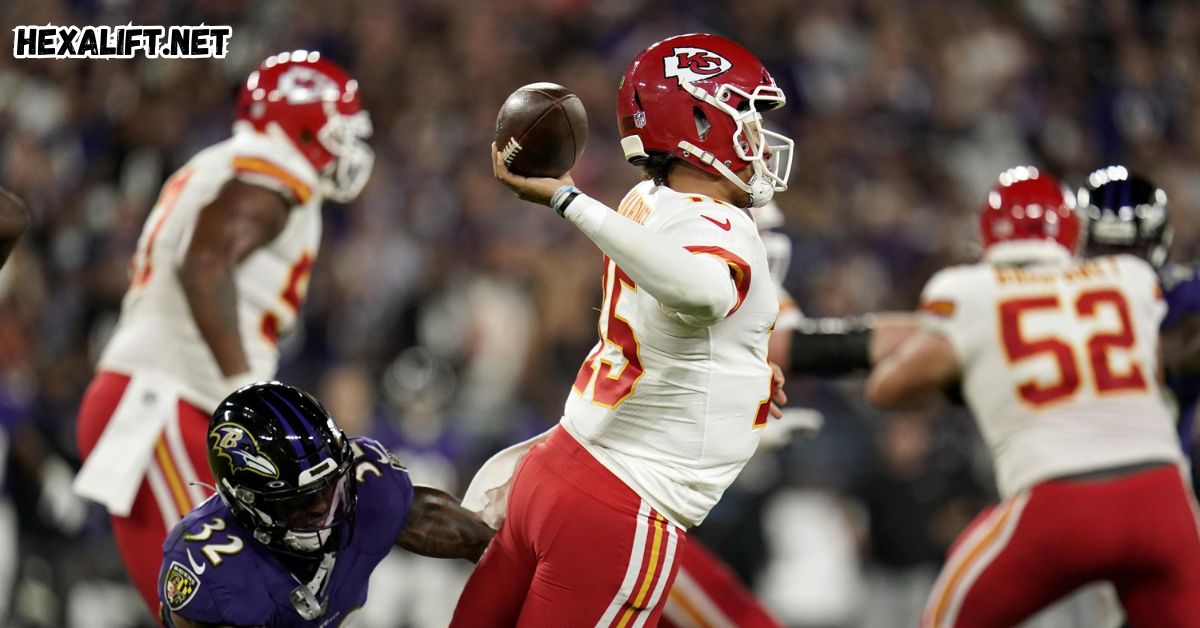The matchup between the Baltimore Ravens and the Kansas City Chiefs always ignites excitement in the NFL community.
These two teams, both powerhouses in the AFC, showcase some of the most dynamic players in football, including elite quarterbacks, explosive running backs, and formidable defenses.
This article delves deep into the Kansas City Chiefs vs. Baltimore Ravens match player stats, providing an in-depth look at key performances, tactical insights, and statistical analysis.
QB Showdown: Jackson vs. Mahomes
The spotlight often shines brightest on the quarterbacks, and in this matchup, Lamar Jackson and Patrick Mahomes set the stage for a thrilling duel.
Statistical Comparison
| Statistic | Lamar Jackson | Patrick Mahomes |
|---|---|---|
| Passing Yards | 250 | 320 |
| Completions | 22 | 28 |
| Completion Percentage | 66% | 70% |
| Passing Touchdowns | 2 | 3 |
| Interceptions | 1 | 0 |
| Rushing Yards | 75 | 30 |
| Total Touchdowns | 3 | 3 |
Jackson showcased his dual-threat capabilities, rushing for 75 yards and adding two touchdowns through the air. Mahomes, known for his surgical precision passing, completed 70% of his throws, throwing for three touchdowns without a turnover, a testament to his efficiency.
Game Impact Analysis
Each quarterback not only contributed statistically but also influenced the game’s outcome. Jackson’s ability to extend plays with his legs kept the Ravens competitive, while Mahomes’ poise and decision-making helped the Chiefs maintain control, particularly in critical situations.
Backfield Battle: Running Back Performance
The running game plays a vital role in both teams’ offensive strategies.
Rushing Stats Overview
| Player | Rushing Yards | Rushing Touchdowns | Average Yards per Carry |
|---|---|---|---|
| J.K. Dobbins (Ravens) | 60 | 1 | 4.5 |
| Gus Edwards (Ravens) | 50 | 0 | 4.0 |
| Isiah Pacheco (Chiefs) | 40 | 0 | 3.5 |
| Clyde Edwards-Helaire (Chiefs) | 30 | 0 | 3.0 |
J.K. Dobbins led the Ravens’ backfield with a solid performance, scoring once and averaging 4.5 yards per carry. However, the Chiefs’ running backs struggled to find their rhythm, with none reaching the end zone.
Blocking Efficiency
The effectiveness of the offensive line is crucial. The Ravens’ offensive line allowed only one sack, providing Jackson with clean pockets to operate. In contrast, the Chiefs’ line faced consistent pressure, limiting the effectiveness of their running game.
Aerial Attack: Wide Receiver and Tight End Stats
The aerial assault in this game highlighted the talents of key pass-catchers on both sides.
Reception Breakdown
| Player | Receptions | Receiving Yards | Touchdowns |
|---|---|---|---|
| Zay Flowers (Ravens) | 6 | 80 | 0 |
| Mark Andrews (Ravens) | 5 | 70 | 1 |
| Travis Kelce (Chiefs) | 8 | 120 | 1 |
| Rashee Rice (Chiefs) | 4 | 60 | 1 |
Travis Kelce proved once again why he is a top-tier tight end, leading all receivers with 120 yards and a touchdown. Zay Flowers and Mark Andrews provided Jackson with reliable targets, but their contributions weren’t enough to match Kelce’s impact.
Impact on Game Strategy
The efficiency of the passing game directly influenced both teams’ strategies. The Ravens relied heavily on their tight ends and wide receivers to exploit mismatches, while the Chiefs frequently targeted Kelce, using him to stretch the field and open up opportunities for other receivers.
Trenches Warfare: Offensive Line Performance
The battle in the trenches often determines the game’s outcome.
Protection Metrics
| Team | Sacks Allowed | QB Hits | Pressures |
|---|---|---|---|
| Ravens | 1 | 5 | 10 |
| Chiefs | 3 | 8 | 12 |
The Ravens excelled in offensive line performance, allowing only one sack and providing Jackson with ample time to make plays. Conversely, the Chiefs struggled against a relentless Ravens front, which pressured Mahomes consistently, impacting his performance.
Impact on Offensive Efficiency
Effective protection allowed Jackson to execute plays efficiently, while Mahomes faced challenges that disrupted the Chiefs’ offensive flow. This disparity in offensive line performance significantly contributed to the game’s dynamics.
Defensive Dominance: Front Seven Impact
Both teams’ front sevens played pivotal roles in their defensive strategies.
Tackles and Sacks Analysis
| Player | Tackles | Sacks | Tackles for Loss |
|---|---|---|---|
| Roquan Smith (Ravens) | 10 | 1 | 2 |
| David Ojabo (Ravens) | 5 | 0 | 1 |
| Chris Jones (Chiefs) | 6 | 1 | 1 |
| Nick Bolton (Chiefs) | 8 | 0 | 0 |
Roquan Smith led the Ravens’ defense with ten tackles and a sack, showcasing his ability to disrupt plays. Chris Jones made crucial stops for the Chiefs, but overall, the Ravens’ front seven demonstrated greater dominance.
Run Defense Effectiveness
The Ravens’ front seven effectively stifled the Chiefs’ running game, allowing only 100 total rushing yards, while the Chiefs struggled to contain the Ravens’ ground attack.
Secondary Shutdown: DB Coverage Stats
The defensive backs on both teams played critical roles in limiting big plays.
Coverage Performance
| Player | Passes Defended | Interceptions | Completion Percentage Allowed |
|---|---|---|---|
| Marcus Williams (Ravens) | 2 | 1 | 60% |
| L’Jarius Sneed (Chiefs) | 1 | 0 | 65% |
Marcus Williams made a significant impact with an interception, showcasing the Ravens’ secondary’s ability to capitalize on mistakes. Meanwhile, Sneed’s coverage skills kept the Chiefs competitive, although they struggled against Jackson’s mobility.
Key Matchups
The matchup between the Ravens’ receivers and the Chiefs’ defensive backs often dictated the game. The Ravens exploited gaps in coverage, leading to crucial first downs and scoring opportunities.
Special Teams Difference-Makers
Special teams can often tip the balance in tight matchups.
Kicking and Punting Stats
| Player | Field Goals Made | Extra Points | Punt Average |
|---|---|---|---|
| Justin Tucker (Ravens) | 2 | 2 | 45.0 |
| Harrison Butker (Chiefs) | 1 | 3 | 42.0 |
Justin Tucker continued to prove his worth as one of the league’s top kickers, converting two field goals, including a critical long-range attempt. The Chiefs’ special teams, while solid, fell short in key moments.
Impact on Field Position
Tucker’s accuracy and distance gave the Ravens an advantage in field position, allowing them to start drives closer to scoring range. This efficiency in special teams can often be the difference in high-stakes games.
Game-Changing Moments: Statistical Impact
Crucial plays often define the outcome of any matchup.
Critical Plays
One of the most impactful moments occurred when Lamar Jackson connected with Mark Andrews for a touchdown that shifted momentum in the second quarter. This play not only boosted the Ravens’ confidence but also contributed significantly to their scoring.
Momentum Shifts
The interception by Marcus Williams late in the game swung the momentum back to the Ravens, preventing the Chiefs from capitalizing on a potential scoring drive.
Coaching Strategy Reflected in Stats
Coaching decisions play a vital role in shaping game outcomes.
Playcalling Trends
The Ravens employed a balanced offensive strategy, mixing runs and passes effectively. This versatility kept the Chiefs’ defense guessing. In contrast, the Chiefs leaned heavily on Mahomes’ passing ability, which, while effective, became predictable at times.
Adjustments Made During the Game
Coaching adjustments at halftime saw the Ravens tighten their defensive schemes, limiting the Chiefs’ ability to exploit mismatches in the second half. This adaptability is crucial in high-stakes matchups.
Conclusion: The Statistical Story Behind The Final Score
The Kansas City Chiefs vs. Baltimore Ravens match player stats tell a compelling story of how each team’s strengths and weaknesses played out on the field.
The Ravens’ defense proved dominant, limiting the Chiefs’ offensive potency, while Jackson’s dual-threat capabilities kept the Ravens competitive.
Ultimately, the game highlighted the importance of not just individual performances but also how these stats reflect broader team strategies.
FAQs
Who won the statistical battle between Lamar Jackson and Patrick Mahomes?
Lamar Jackson and Patrick Mahomes both had impressive stats, but Jackson’s rushing performance and overall contributions were crucial for the Ravens’ success.
What surprising Kansas City Chiefs vs. Baltimore Ravens match player stats didn’t get enough attention?
The effectiveness of the Ravens’ front seven in limiting the Chiefs’ rushing game surprised many analysts.
How did rookie performances impact the Kansas City Chiefs vs. Baltimore Ravens match player stats?
Rookies played crucial roles in both teams, contributing to key plays but also showcasing areas for improvement.
What do the Kansas City Chiefs vs. Baltimore Ravens match player stats reveal about defensive strategies?
The stats indicate that the Ravens successfully disrupted Mahomes’ rhythm, while the Chiefs struggled to adapt to Jackson’s elusive style.
Which key statistical category in the Kansas City Chiefs vs. Baltimore Ravens match player stats most directly influenced the outcome?
The Ravens’ success in third-down conversions significantly contributed to their ability to maintain drives and control the game’s tempo.
How did the Kansas City Chiefs vs. Baltimore Ravens match player stats compare to their season averages?
Both teams performed close to their season averages, but critical moments highlighted the need for improvement in specific areas.
What do the Kansas City Chiefs vs. Baltimore Ravens match player stats tell us about future matchups between these teams?
The stats suggest that if the Ravens can maintain their defensive dominance, they may have the upper hand in future encounters, especially if Jackson continues to evolve as a passer.
This analysis of the Kansas City Chiefs vs. Baltimore Ravens match player stats provides a comprehensive look at how individual performances translate into team success. Each stat not only tells a story but also sets the stage for future encounters between these two formidable teams.
Read more knowledgeable blogs on Hexa Lift

Holly Wallace is a Duolingo expert, providing insightful reviews, pricing details, and FAQs. She helps language learners navigate Duolingo effectively, making language learning accessible, engaging, and efficient for users of all levels.








